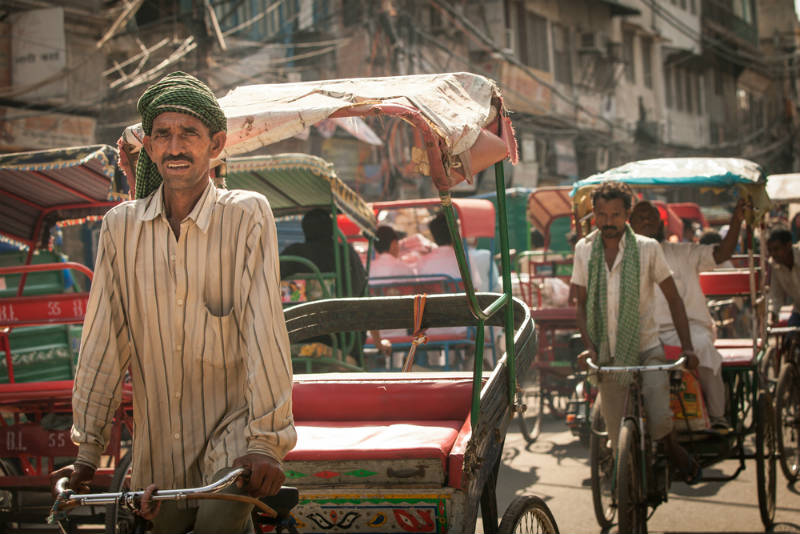India’s ambitious plan to build 100 smart cities could face formidable challenges, some of which are unique to the country.
Much hype and excitement surrounds India’s plan to build 100 smart cities, with 20 already selected in the first, competitive round. The government plans to invest $7.6 billion in these cities with more funding to be raised from private companies and through monetization of services. The second round of the smart cities program starts in April.
Each of the selected cities has identified discrete areas that will serve as prototypes for other regions. They include solid waste management, security, health care, traffic management, parking and even crowd management during festivities. Running themes across the projects are the use of IT connectivity, e-governance and citizen participation.
To be sure, the cities have their work cut out—not only do they have to translate proposals into specific project requirements, but they also have to find and manage the funds for the projects and ensure a transparent process that promises regulatory predictability and a line of sight on returns for investors. They also have to contend with circumstances unique to India, such as the lack of a deep enough secondary corporate bond market for investors to freely enter and exit, often fractious relationships between state and city governments, and time-consuming public works processes, among others.
Mumbai Lost, Tiny Kakinada Won
The objective of India’s smart cities program is “to promote cities that provide core infrastructure and give a decent quality of life to its citizens, a clean and sustainable environment and application of ‘smart’ solutions,” according to India’s Ministry of Urban Development, which is spearheading the smart cities program. It wants to focus on “sustainable and inclusive development” and create “replicable models” of compact city areas that will act “like a lighthouse to other aspiring cities.”
The ministry has identified responsibilities for the cities, which include providing water and sewage infrastructure, waste water treatment, solid waste management and sanitary landfills, primary education and health care, slum upgrades, local roads, public transport and street lighting.
The cities were selected based on scores they received from their responses to a detailed questionnaire. Among other aspects, it covered their track record over the past three years in areas such as improved livability, sustainability and economic development, the use of technology and how they leveraged citizen engagement.
“It is a completely bottom-up process,” said Sameer Sharma, joint secretary (smart cities) in the Ministry of Urban Development at the “One Globe: Uniting Knowledge Communities” conference held recently in New Delhi, where the main theme was smart cities. “The focus is on competition, on results orientation and do-ability, and not just ideas … [Having a] vision is fine, but every step has to be tied into that vision.”
Among the cities the country selected, big metropolitan areas such as Mumbai and Bangalore lost, while much smaller Kakinada (population of about 300,000) in Andhra Pradesh state won. He noted that Kakinada scored points with an innovative feature that allowed differently abled people to participate in the conceptual process, such as with Braille keyboards.
Finding the Money
According to Sharma, the larger plan for 100 smart cities will need about $30 billion in the initial build-out. While government funding would cover much of that, the private sector must bring in more than $10 billion, he said.
Initial funding for smart cities will come from the government. Each selected city is entitled to $75 million from the central government over four years, with state and city governments expected to make matching contributions. Other funding sources include property, professional and entertainment taxes, monetization of services, public-private partnerships, municipal bonds, borrowings and the National Investment and Infrastructure Fund, according to the urban development ministry.
The smart city projects will be implemented through special purpose vehicles, or SPVs, created by those municipalities. The SPVs are permitted to enter into joint ventures with other entities to raise capital. These will be autonomous bodies accountable to the city, with majority ownership held by government agencies. The private sector and financial institutions could hold minority equity stakes.
The funding has to come in at three levels, according to Jerry M. Hultin, chairman of the Global Futures Group, a consulting and financial services firm specializing in smart cities. Venture capital is required in the early stages; followed by project financing and long-term financing, he told Knowledge@Wharton. Project finance investors must be willing to wait five to 10 years before revenues start flowing from their projects, while long-term capital must have a horizon of 10 to 30 years and buy out project finance investors, he said. Such long-term investors would include pension and insurance funds and sovereign funds, he added.
Monetization Opportunities
Purushottam Kaushik, the Mumbai-based managing director of Cisco Systems (India), expected that part of the funding needs would come from monetization opportunities in the cities. Cisco has provided engineering services to several smart city projects including Barcelona, Chicago, Adelaide, Dubai and Hamburg, and is active in several Indian cities as well.
Smart city solutions cannot always be directly transferred to Indian cities, many of which have unique needs. In the city of Ujjain in Madhya Pradesh, Municipal Commissioner Avinash Lavania is preparing for an influx of about 50 million people …
A prime area of monetization for municipalities is to sell the right-of-way to providers of telecom, electricity and other services in ducts they could lay across their cities, Kaushik told Knowledge@Wharton. Digging streets to lay cables accounts for up to 90% of project costs.
In general, cities could generate more revenues through fees on delivery of services, according to the Ministry of Urban Development. In a sampling of five cities including Hyderabad and Lucknow, it found that city revenues cover between 8% and 55% of the cost to provide urban services. It advises cities to link user charges to improved quality of service, and increase them in a phased manner to cover at least operations and maintenance costs.
“In some ways, monetization is easier if you have profound ways of using technology in cities to be smart,” said Hultin, who participated in several panels on smart cities at the conference. He pointed to San Francisco-based Uber, whose cab-hailing app leverages mobile phone and cloud technology to connect cab drivers and riders in dozens of countries. “Uber demonstrates that you can create enormous value by providing a relatively simple service,” Hultin added, noting that Uber’s growth in India has been “substantial,” spanning 250,000 drivers nationwide in its network.
Patient Investors Needed
Smart city projects need investors with patience and an appetite for social impact. “Everyone likes the social media, Facebook [model], where I go from 25 people to 5 billion people and I get valuations in the sky,” said Hultin. “Doing things in cities is a little slower. You have to work with the city government and you have to sell a product or service, so you are not going to see Facebook returns, but you will see decent returns.” He said returns on infrastructure projects tend to be “slow and steady,” averaging about 7% annually over 30 years.
Smart cities will also attract social impact investments, where investors settle for lower returns than they would otherwise get in exchange for the satisfaction of doing something good. “An example would be an app that helps moms keep track of their kids from the time they leave school until they get home,” said Hultin. “That app may make some money, probably not Facebook-type money, but on the other hand it does a lot of social good.”
By design, smart cities also help minimize graft, said Hultin. He pointed to the Aadhaar program of the Unique Identification Authority of India, which allows payments to be made directly to individual beneficiaries’ accounts. “It eliminated the middleman and is a smart solution,” he added. “You start using these systems and you will be surprised how much of that corruption disappears because sunlight shines on it and it withers.”
In order to be successful, a smart city first needs “a consumer population that demands or likes better quality, pursues it and turns down inferior products,” said Hultin. Next, it needs several alternative providers so that consumers have choices, he added. “That process is what [Indian Prime Minister Narendra] Modi understands, and that is why he had the competition [for smart city contenders].”
Spreading the word to communities also needs innovative solutions, said Rajyavardhan Singh Rathore, India’s minister of state for information and broadcasting. He wants to disseminate information on government policies to rural youth. His plan is to increase FM radio coverage across the country from 45% of the country to 65% in the next two to two-and-a-half years. Much of that would be achieved by installing digital FM transmitters on cell towers that already cover 98% of the country, he said.
Solutions Specific to India
Smart city solutions cannot always be directly transferred to Indian cities, many of which have unique needs. In the city of Ujjain in Madhya Pradesh, Municipal Commissioner Avinash Lavania is preparing for an influx of about 50 million people—100 times bigger than its population—in April and May this year. The occasion is the “Simasth Kumbh Mahaparv,” a major religious event that Ujjain hosts once every 12 years when a rare planetary configuration occurs. People descend on the city to take “holy dips” in the River Shipra on 11 auspicious days spread across a month.
It helps Lavania that Ujjain was selected in the first round of smart cities. He said his administration is investing in technology solutions to provide water, electricity and waste management, housing and others. Delivery of services such as solid waste management and street lighting will be remotely managed through a command center, since physical movement will be restricted. Plans also include the creation of two railway stations, six satellite towns to house the visitors, and an elaborate network of police posts.
The objective of India’s smart cities program is “to promote cities that provide core infrastructure and give a decent quality of life to its citizens …
“A typical technology solution would be deploying a video surveillance system that is analytics-based,” said Kaushik, whose company is working on projects in Ujjain. That would include features such as facial recognition, maintaining cleanliness in waste collection, tracking baggage theft as well as specific individuals as part of anti-terrorism measures. “With such a big gathering, if some 10 to 15 lights go off, it could lead to stampedes,” he added, noting that energy management and connectivity would be critical.
In the city of Jaipur in Rajasthan state, Shikhar Agrawal, its development commissioner, has set up task forces for functions such as traffic management and exposed them to “smart” technology solutions. For example, the surveillance system builds on CCTV cameras with data analytics and other special features such as tracking baggage left unattended for 30 minutes or more, and responding to a “boom” sound that may have been caused by a bomb. One-stop delivery of city administrative services is another theme. For example, residents could conduct a variety of tasks such as paying bills, applying for a new electricity connection or filing a police complaint through an integrated and interactive system.
“Smart city solutions need to be customized and not directly adopted from a Barcelona,” said Kaushik. They have to be customized to the scale and requirements of Indian cities, ruggedized to deal with problems like dust pollution; and built with cost structures to make them viable.
For example, a Cisco project in Mumbai on traffic management with attendant safety and surveillance features captures vehicle license plates at toll gates and matches them with a central database. Under the current system, no standardization exists on the languages, letter sizes and fonts used on license plates, as well as where they are placed on vehicles.
Investor Concerns
While smart cities hold plenty of promise, challenges also abound. Rahul Gupta, GE managing director responsible for the ASEAN region, said: “Investors need to be assured of speed and plug-and-play processes before they invest a single dollar.” Hultin added: “A lot of project performance is slow and doesn’t deliver, so you need better management of that.”
Investors want predictability, said Rashi Dhir, senior partner at the New Delhi-based law firm DMD Advocates. That could be achieved with smoother ties between the central and state governments, and “new mandates for bureaucrats to be [friendlier],” he added. He also called for a balance between government objectives and investor expectations. “The government cares more about social needs than profitability, but you need to make money [from smart-city ventures] to plough it back,” he said.
Accountability from project managers to creditors is another important factor, said Dhir. “If you feel you don’t have to pay back your bank, it chokes liquidity,” he added. He called for a strong bankruptcy code and exit policies for investors, noting that they fear the risk of project delays. “It is not about whether you resolve it but how quickly you resolve it,” Dhir said. Current bankruptcy proceedings could take up to three years.
“There is a mismatch between project tenure, short-term lending and returns expectations [of investors],” said Nandita Agarwal Parker, managing partner of investment firm Karma Capital Management. She said those could be addressed with a well-developed corporate bond market, but the lack of it in India could hurt investments in smart cities by the corporate sector and banks. The current system “doesn’t have market pricing, promotes relationship banking, lazy banking and crony capitalism,” she said. Agarwal also pointed to the need for a new set of owners who could buy and turn around distressed assets in such cities as they work on renewal projects.
Mayoral Power
Decentralization of power within city administrations will be crucial to ensure the program’s success, said Sharma of the urban development ministry. Every spending proposal need not require approval from mayors, and “we are trying to dismantle that model,” he added.
Hultin chimed in: “India needs to give mayors more power.” He advocated for stronger combinations of city councils and mayors to enable them to build their credit ratings and raise money through bonds. However, he did not think political divides would come in the way of smart cities. “Urbanization is a little bit like the tide—it is just going to happen, with 70% plus living in cities,” he said. Over time, different political interests would converge on how best to serve those populations.
 “It is extremely difficult to give the assurance to the private sector partners that you are going to deliver on your promises,” said Montek Singh Ahluwalia, former head of India’s Planning Commission. It is unclear as to whether the state government or city municipality will provide that assurance. “It has to do with devolution of power from the state to the city,” he added.
“It is extremely difficult to give the assurance to the private sector partners that you are going to deliver on your promises,” said Montek Singh Ahluwalia, former head of India’s Planning Commission. It is unclear as to whether the state government or city municipality will provide that assurance. “It has to do with devolution of power from the state to the city,” he added.
Ahluwalia said mayors of Indian cities need to be empowered more than they are now to implement smart city programs. He recalled that in December 1988, when he accompanied former Indian Prime Minister Rajiv Gandhi on a visit to China, one intriguing engagement was a meeting with the then-mayor of Shanghai, which was the country’s most industrially developed and wealthiest city. His inquiries revealed that the mayor was tipped to be the next Chinese premier. That mayor was Zhu Rongji, who went on to serve in that position from 1998 to 2003.
“There is no way the mayor of an Indian city will become the prime minister,” said Ahluwalia.
*[This article was originally published by Knowledge@Wharton, a partner institution of Fair Observer.]
The views expressed in this article are the author’s own and do not necessarily reflect Fair Observer’s editorial policy.
Photo Credit: Jesus Sanz / Elena Ermakova / Maxx-Studio / Saiko3p / Shutterstock.com
 We bring you perspectives from around the world. Help us to inform and educate. Your donation is tax-deductible. Join over 400 people to become a donor or you could choose to be a sponsor.
We bring you perspectives from around the world. Help us to inform and educate. Your donation is tax-deductible. Join over 400 people to become a donor or you could choose to be a sponsor.
Support Fair Observer
We rely on your support for our independence, diversity and quality.
For more than 10 years, Fair Observer has been free, fair and independent. No billionaire owns us, no advertisers control us. We are a reader-supported nonprofit. Unlike many other publications, we keep our content free for readers regardless of where they live or whether they can afford to pay. We have no paywalls and no ads.
In the post-truth era of fake news, echo chambers and filter bubbles, we publish a plurality of perspectives from around the world. Anyone can publish with us, but everyone goes through a rigorous editorial process. So, you get fact-checked, well-reasoned content instead of noise.
We publish 2,500+ voices from 90+ countries. We also conduct education and training programs
on subjects ranging from digital media and journalism to writing and critical thinking. This
doesn’t come cheap. Servers, editors, trainers and web developers cost
money.
Please consider supporting us on a regular basis as a recurring donor or a
sustaining member.
Will you support FO’s journalism?
We rely on your support for our independence, diversity and quality.

















